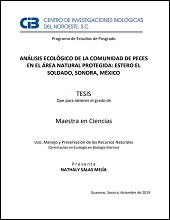| dc.contributor.advisor | Arreola Lizárraga, Jose Alfredo | |
| dc.contributor.author | SALAS MEJIA, NATHALY | |
| dc.date.issued | 2019 | |
| dc.identifier | https://cibnor.repositorioinstitucional.mx/jspui/handle/1001/1832 | |
| dc.identifier | | |
| dc.identifier.uri | http://dspace.cibnor.mx:8080/handle/123456789/3012 | |
| dc.description.abstract | "El objetivo de este estudio fue conocer la composición, abundancia y diversidad actual de la comunidad de peces en un ciclo anual y su relación con variables ambientales, así como comparar con la composición y diversidad observada hace cuatro décadas en el área natural protegida estero El Soldado, Sonora, México. La captura de peces se realizó cada mes en tres sitios del sistema, durante mayo 2018-abril 2019 con una red de arrastre. En cada sitio, se registraron la temperatura, salinidad y oxígeno disuelto del agua, también se recolectaron las macroalgas (MA) en la red, y se determinó su biomasa en peso seco (kg. ha-1). Se elaboraron gráficos para presentar el comportamiento de las variables ambientales, y adicionalmente se incorporó la textura y materia orgánica de sedimento de cada sitio para determinar su similitud mediante un análisis multivariado de escalamiento multidimensional no métrico (nMDS). Se realizó la descripción espacial y temporal de la abundancia (ind. ha-1 y kg. ha-1) de los peces y se estimaron la riqueza de especies (S), diversidad de Shannon (H´) y equidad de Pielou (J’); así como el índice de diversidad taxonómica (Δ+) y su varianza (Λ+); y el índice de similitud de Bray-Curtis (S��). Las diferencias entre los sitios y entre los meses se examinaron con un análisis no paramétrico de Kruskal-Wallis (p < 0.05.). Se generó un elenco sistemático, y se caracterizó a las especies con base en su afinidad biogeográfica, nivel y gremio trófico. También, se determinaron las especies dominantes en base a su clasificación jerárquica, índice de valor biológico e índice de importancia relativa. Por último, la comunidad de peces de mayo 2018 - abril 2019 se comparó con la observada en mayo 1977 - mayo 1978; ambos estudios con capturas mensuales, en los mismos sitios de muestreo y con el mismo tipo de red. La comparación se realizó con base en el número de especies (S), la diversidad taxonómica (Δ+) y su varianza (Λ+), así como con el análisis de similitud mediante el índice de Jaccard (SJ)..." | es |
| dc.format | pdf | es |
| dc.language.iso | spa | es |
| dc.publisher | Centro de Investigaciones Biológicas del Noroeste, S.C. | es |
| dc.rights | Acceso abierto | es |
| dc.subject | peces, laguna costera, El Soldado, área natural protegida, Sonora | es |
| dc.subject | fishes, coastal lagoon, Protected Natural Area | es |
| dc.subject.classification | PROTECCIÓN DE LOS PECES | es |
| dc.title | ANÁLISIS ECOLÓGICO DE LA COMUNIDAD DE PECES EN EL ÁREA NATURAL PROTEGIDA: ESTERO EL SOLDADO, SONORA, MÉXICO | es |
| dc.type | masterThesis | es |
| dc.dirtesis.grado | Maestría en Ciencias en el Uso, Manejo y Preservación de los Recursos Naturales | es |
| dc.dirtesis.disciplina | Biología Marina | es |
| dc.dirtesis.universidad | Centro de Investigaciones Biológicas del Noroeste, S.C. | es |
| dc.dirtesis.facultad | Posgrado en Recursos Naturales | es |
| dc.description.abstracten | "This study presents the composition, abundance and diversity of the fish community in an anual cycle and its relationship to environmental variables, as well as compare with the composition and diversity observed four decades ago in the Estero El Soldado Protected Natural Area, Sonora, México. Fish were caught each month at three sites in the system, during May 2018-April 2019 with a trawl. At each site, the temperature, salinity and dissolved oxygen of the water were recorded, the macroalgae (MA) were also collected in the net, and their biomass was determined in dry weight (kg. ha-1). Graphs were developed to present the behavior of environmental variables, and also was incorporated the texture and organic sediment material of each site to determine its similarity using a multivariate analysis of multidimensional nonmetric scaling (nMDS). A spatial and temporal description of the abundance (ind. ha-1 and kg. ha-1) of the fish was made, and species richness (S), Shannon diversity (H´) and Pielou equity (J´) were estimated; as well as the taxonomic diversity index (Δ+) and its variance (Λ+); and the Bray-Curtis similarity index (S��). Differences between sites and between months were examined with a non-parametric Kruskal-Wallis analysis (p <0.05.). A systematic cast was generated, and the species were characterized based on their biogeographic affinity, level and trophic guild. Dominant species were determined based on their hierarchical classification, biological value index and relative importance index. Finally, the fish community from May 2018-April 2019 was compared with that observed in May 1977-May 1978; both studies with monthly catches, in the same sampling sites and with the same type of net. The comparison was made based on the number of species (S), taxonomic diversity (Δ+) and their variance (Λ+), as well as with the similarity analysis using the Jaccard index (SJ). The results showed that the four seasons of the year had different average temperature values (15-32 °C) and the fish community was structured in groups associated with each season of the year with greater similarity between summer and autumn, attributed to the higher species richness was observed in both July and August (summer) and in October and November (autumn); the highest density of fish was observed in June and July (warm months), and the lowest density in December, January and February (cold months)..." | es |
| dc.audience | https://cibnor.repositorioinstitucional.mx/jspui/handle/1001/1832 | |

